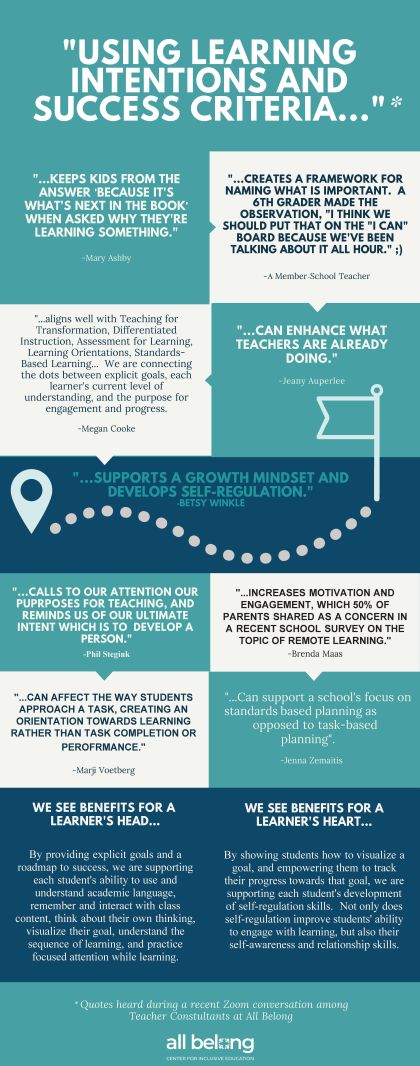Assessment, Success Criteria, Looking Forward
We hope you’ve been reading or listening to our previous posts on the topic of assessing learning during this time of at-home teaching. In the first post, we prioritized learning over learner compliance, and we established assessment as a tool for measuring our impact on student learning. In the second post, we shared about learning intentions, which are statements that provide relevance to learning and, therefore, learner engagement by identifying what it is that a teacher intends her students to know, understand, or be able to do through interacting with a lesson, activity, or experience. To clarify, it is the process of identifying clear goals for students that generate engagement (what some call motivation). Assessment itself is not meant to provide relevance for learning or induce engagement, nor should assessment be leveraged with this kind of intent.
Assessments communicate our expectations for learning, but we hope to have shared our expectations well before a final test is administered. When using assessment as a tool for learning, teachers will provide a clear path toward proficiency with milestones identified along the way.
During this time of remote teaching, we are no longer able to walk around our classrooms for informal check-ins or to monitor students’ work process. Because of the decrease in personal or synchronous contact with our students, there is a chance that a student’s poor grade on a test might be our first indicator that she did not understand a concept.
Success criteria are designed to "signal the learner about the destination and provide a map for how they will get there."
Ideally, students are aware of their progress towards proficiency before taking a test. How do we best facilitate this process, especially while teaching remotely?
Although learning intentions are a key component in communicating expectations before and/or during a learning cycle, when learning intentions are coupled with success criteria, students can visualize success and develop a plan for getting there.
Success criteria are designed to “signal the learner about the destination and provide a map for how they will get there” (Frey, Hattie, Fisher, 2018, p. 41). They are statements that follow learning intentions and unpack–just as their name implies–the criteria for reaching success.
In the book "Visible Learning for Teachers" (2012), Hattie shares his synthesis of over 800 meta-analyses of education research studies and determines the effect sizes of various influences on learning outcomes; learning intentions and success criteria have an effect size of .54, which Hattie considers to be a “desirable effect” since it is larger than the effect size of a typical year of teaching (.40).
Crafting Success Criteria
There is hope in applying success criteria now, in these final days of the school year. Even if used for one lesson, success criteria will work to sharpen teacher clarity, heighten learner engagement, and build your students’ awareness of their learning. For teachers who have remaining assessment goals to complete this school year, success criteria will further aid your students' understanding of their progression towards success before final assessment (Fisher, Frey, Amador, Assof, 2019, p. 30).
There are numerous ways to craft success criteria, but the most widely known is through writing “I Can” statements. Here is a video clip of a 3rd-grade teacher from one of our member schools, taken from the beginning of an ELA online lesson. She is communicating an “I Can” statement during this time of remote learning:
Success criteria note the specific and attainable criteria that lead to mastery of the learning intention, utilizing student-friendly language and vocabulary. Vague criteria such as “try hard” and “do your best” will not suffice, nor will a list of tasks such as “complete the science lab” or “today we’re going to dissect a frog.” These examples do not prompt students to visualize success or identify any plan for getting there. Here are some helpful and varied examples of success criteria tied to learning intentions.
John Hattie (2012) explains that inviting students to co-construct success criteria deepens the learning process and a student’s ability to predict their success. Learning becomes more visible, he adds, when we allow ourselves to view learning through the eyes of the students. Here is an example of a teacher inviting her students to generate success criteria for an art lesson, and here are other ideas for co-constructing success criteria with your students.
Why Success Criteria Work

The right amount of challenge supports the drive for further development (check out Yerkes Dodson's law of arousal, goldilocks principle, and zone of proximal development), and success criteria can augment a disposition open to a more significant challenge, cultivating a strengthened desire for mastery (Frey et al., 2018, p. 66).
For some insight into why this might be, authors Fisher et al. explain that success criteria “tap into the principles of human motivation, sharing that when students know what success looks like, they are more likely to plan and predict, set goals, and acquire a stronger sense of how to judge their progress” (Fisher et al., 2019, p. xvi). Students will be more engaged with their learning through the provision of explicit and precise goals set al., 2019, p. xvi).
According to Fisher, et al., students will be more engaged with their learning through the provision of explicit and precise goals, and the ability to compare their current performance with those goals. Specifically, success criteria can make students aware of any dissonance in their thinking, which then generates a desire to get rid of that dissonance (Fisher et al., 2019, p. 30). Theorist Piaget described this as a process of assimilating or accommodating information, driven by a strong desire to replace an uncomfortable state of disequilibrium with a state of equilibrium or internal balance.
Using Success Criteria to Judge One’s Own Progress
We do not want to share success criteria only once, never allowing students to consider their progress toward each criterion. This would undermine the seemingly magical powers of dissonance. Here is a sharable rubric for teacher and student to reflect together on criterion progress; please feel free to change the measures in the rubric to be most helpful for your grade and content.
Hattie (2015) highlights the positive effects of progress cues given while children are playing video games; when children know what the next goal is and feel that they are part of the solution to getting there, they persist. We can have similar positive effects on students’ persistence, Hattie says, by teaching them how to clearly define the next goal, to look for cues of progress, and to view themselves as part of the solution. Reflecting on success criteria can foster these skills and enable students to take ownership of their learning by judging their progress.
Criterion-Guided Assessment
We’ve shared examples of success criteria from experienced users. Please be encouraged that the strength of using success criteria will not be lost if/when you do not feel creative or confident in your plans to communicate them. When you are next able to share your learning intention with your students, ask them how they’ll know they’ve succeeded. Write it all down, share it with them, and later ask them if that was helpful and why. In doing so, you have made your students’ learning visible and improved your teacher's clarity (Hattie, 2012). When you’re ready to explore further how success criteria can enhance assessment and vice versa, check out this “how-to” guide and this list of resources for assessing criteria before, during, and after instruction.
Leaders are dutifully looking ahead to the next school year. Johns Hopkins University Institute for Education Policy and Chiefs for Change recently shared projections regarding assessment in their collaborative publication titled, The Return: How Should Education Leaders Prepare for Reentry and Beyond? (2020). Urging us to contemplate the messages brought home by COVID-19, including student and teacher needs in response to dramatic disruptions, the authors describe the upcoming role of assessment within a coherent pathway toward learning recovery and acceleration. Assessments, the authors posit, commission teachers' power to differentiate instruction, mitigate bias, and develop proper expectations; reciprocally, these powers are indebted to “formative and summative assessments tied to specific curricula” to receive “actionable data on not only skills but also conceptual and specific knowledge” that reflect classroom content (The Return, 2020, p. 9).
Your energy in understanding assessment’s role in learning and the power you give to your students each time you try your hand at learning intentions and success criteria are already meeting the goals set before our profession.
A special thank you to Eena Wright for sharing her video with All Belong, showcasing her use of "I Can" statements in a video for her 3rd-grade class.
References
- Ellefsen, K.O., (2014), The evolution of learning under environmental variability, https://www.researchgate.net/f...
- Frey, N., Hattie, J. & Fisher, D., (2018), Developing assessment-capable visible learners: Grades K-12, Thousand Oaks, CA: Corwin, a Sage Co.
- Fisher, D., Frey, N., Amador, O. & Assof, J., (2019), The teacher clarity playbook: A hands-on guide to creating learning intentions & success criteria for organized, effective instruction, Thousand Oaks, CA: Corwin, a Sage Co.
- Ha Dang, T. & Tapus, A., (2013), User modeling in adjustable control system, , https://www.researchgate.net/f...
- Hattie, J., (2012), Visible learning for teachers: Maximizing impact on learning, New York, NY: Routledge
- Hattie, J., (2015), Professor Hattie on communicating the learning target, Corwin Youtube, https://www.youtube.com/watch?...
- Johns Hopkins University Institute for Education Policy & Cheifs for Change, (2020), The return: How should education leaders prepare for reentry and beyond? https://chiefsforchange.org/wp...
- McLeod, S., (2018), Jean Piaget's theory and stages of cognitive development, Simply Psychology, https://www.simplypsychology.o...
- McLeod, S., (2019), The zone of proximal development and scaffolding, Simply Psychology, https://www.simplypsychology.o...

Phil Stegink
Teacher Consultant, Special Projects
Phil Stegink works on special projects for All Belong and is an assistant professor of special education at Calvin College.
